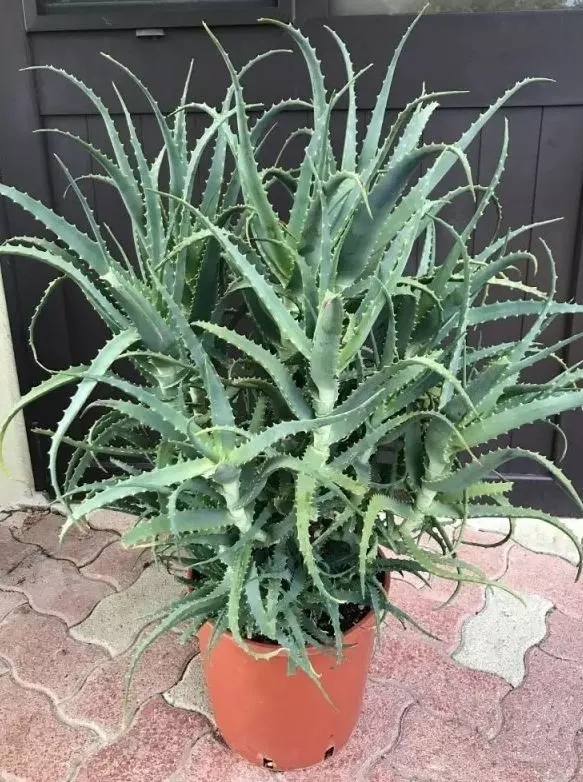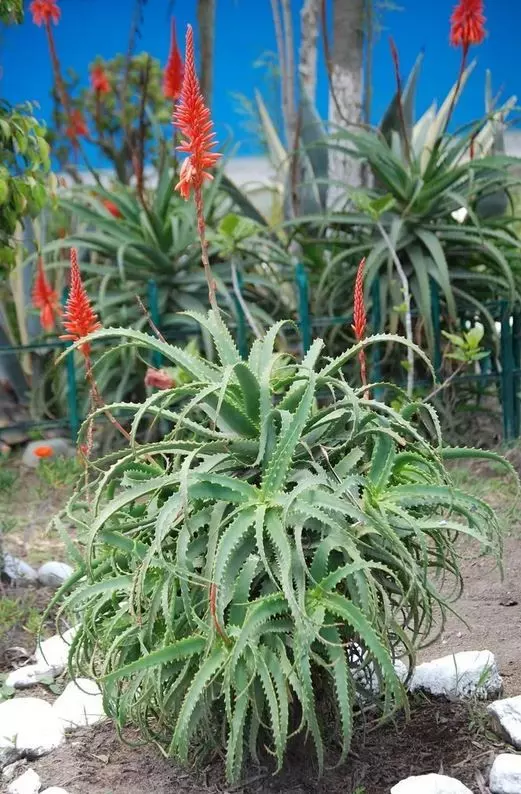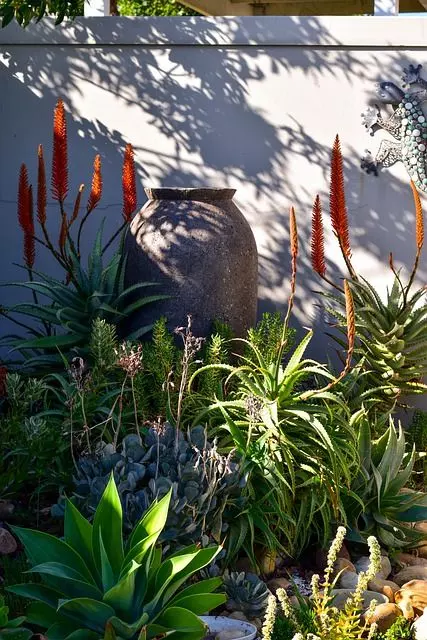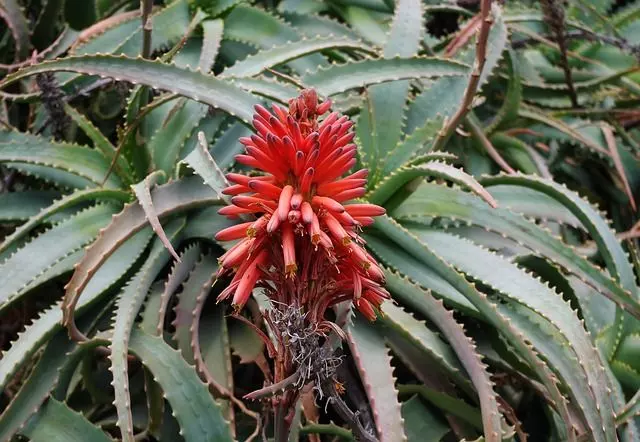Aloe arborescens has beautiful large flowers, attractive foliage, a decorative shape, and is very easy to grow. It is also a “must-have” for anyone who wants to stock their herb gardens with healing plants. Learn all about Aloe arborescens care in this article.
Table of Contents
Description
Aloe arborescens develops into a multi-headed shrub 7 – 10 ft (2 – 3 m) tall with showy gray-green leaves arranged in attractive rosettes. The leaf margins are armed with conspicuous pale teeth.
Leaves Aloe arborescens
Large, colorful flower spikes are borne in abundance during the cold African winter months (May-July), brightening up a drab winter garden.
Intense orange is the most common color, but there are also pure yellow forms, and an unusual bicolor form of intense orange (almost red) and yellow. The inflorescence is not usually branched, and from a single rosette arise from two to several. Like all aloes, the flowers produce nectar and are attractive to many types of birds, particularly small, colorful hummingbirds, which flit from flower to flower in search of nectar. The flowers also attract bees.

“Krantz aloe or Candelabra”.
Aloe arborescens is a variety of aloe; succulent, perennial, and flowering. It is endemic to the southeastern part of southern Africa and although it has adapted to many different habitats, its natural habitat usually consists of mountainous areas including rocky outcrops and exposed ridges.
It has the third widest distribution of the aloes and its habitat can vary and is one of the few aloe species found growing from sea level to mountain tops.
A Quick Look at its Characteristics:
This plant prefers to be in full sun.
It tolerates cold well down to 24.8°F (-4 ºC).
Aloe arborescens grows between 7 – 10 ft (2 – 3 m) in height. Growing up to 7 ft (2 m) horizontally.
For it to develop well indoors it needs direct sunlight.
Reproduction by tillers, but also by seeds and cuttings.
Prefers hot, dry climates.
Slightly lower water requirements than the rest of the aloes.
It is not toxic to humans but can be toxic to dogs and cats.
It should be planted in May / June and blooms in these same months.
Care and Propagation Aloe arborescens
Care Aloe arborescens
This Aloe is a very easy plant to maintain, but if we had to mention a key aspect for this aloe it would be light, as it is one of the varieties of aloe that require more direct light.
They tolerate well the indoor conditions of houses and dry environments and although it develops very well in temperatures of 68 to 86°F (20 to 30 ºC) if we want to encourage its flowering, we must give them a little winter with temperatures no higher than 50°F (10 º C).

Watering Aloe arborescens
The Aloe arborescens is one of the most sensitive aloes to excess water, I say this from the experience of killing a beautiful plant by excessive watering. We will use the “soak and dry” method by letting the soil dry out completely between waterings.
If we are going to give the plant a winter, with temperatures below 50°F (10 ºC) it is better to water less frequently since the plant is resting and inactive.
Where to Plant Aloe arborescens
Aloe arborescens is an easy and rewarding plant to grow, being a perfect aloe for a garden in many countries where temperatures do not drop below 24.8°F (-4°C) and the climate is mainly dry.
It is a very popular garden plant in many countries grown mainly as an ornamental or accent plant, but it is also an excellent and impenetrable hedge plant.
As we have already said it is an aloe that should be planted where it gets direct sun and lots of it, either indoors or outdoors. Use well-drained soils and if planted in pots, use large pots that allow the plant to develop its roots well.

Aloe arborescens Propagation
This aloe reproduces primarily by two means: seeds and cuttings.
Cuttings are born at the base of the trunk. These small new rosettes are usually attached to the parent by a short subway stolon and may already have roots, which must be maintained for reproductive purposes. Cuttings from the top of the plant can also be used but as they are not rooted, these are more difficult to use.
Since very small cuttings are difficult to root, they should not be removed for planting until their leaves have begun to open into the characteristic rosette shape.
Cuttings will usually root in two to three weeks in a standard substrate mix and if some coarse sand is sprinkled at the base of the rosette to prevent rotting. Until the cuttings are well established, they should have bright light without direct sunlight and should be watered sparingly, just enough to moisten the potting mix, allowing the top two-thirds of the mix to dry out between watering.
Uses
Data from independent laboratories in the United States have shown that Aloe arborescens contains molecules that possess the highest immunomodulatory activity (substances that affect the immune system). The full complement of complex carbohydrates and other phytonutrients (nutrients derived from plant material) are also present to help achieve maximum health benefits.
Recent studies conducted by the Palatinin Salzano Venezia Institute in Italy found that Aloe arborescens is 200% richer in ritual compounds than aloe vera. Research has also indicated that it has more properties than other varieties of aloe for cancer and other tumor treatments.

